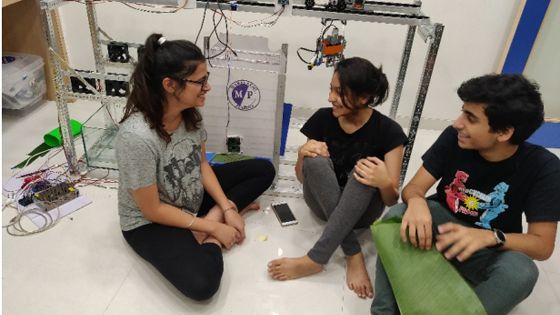Banana leaf food packaging

Plastic cutlery, newspaper packaging, or even aluminium foil not only cause health hazards but also hamper food security. While the aluminium from the foil leaching into your hot food is said to cause Alzheimer's and kidney ailments, plastic and ink from newspapers are carcinogenic. But an award-winning team of 16-year-olds from Mumbai has found an alternative. Whether it is serving Kerala's traditional sadhya (a feast of traditional vegetarian dishes) or steaming the Mangaluru delicacy pathrode (made from roasted colocasia leaves, stuffed with rice flour and flavourings such as spices, tamarind and jaggery), the banana leaf has been an intrinsic part of Indian culture.
The students at the city-based On My Own Technology (OMOTEC) Institute have leveraged these qualities of the locally-available and financially viable leaves to develop a unique packaging solution. Christened EverGreen, they have built a prototype of a packaging machine that not only secures food hygiene but also has the power to ensure additional income to farmers.
The prototype that we have built follows a multistage process to complete the packaging. From cutting the leaf, to scanning it for safety, followed by boiling, drying, sterilizing and folding. The process begins with you placing a banana leaf on to the cutting apparatus, which cuts it into rectangular pieces of fixed sizes by slicing the surface using blades. A rack-and-pinion mechanism ensures that the blades are moved, lowered and raised accurately. Once cut, the EV3 brick on the rover is wirelessly alerted to pick the leaf up and carry it to the next stage, which is scanning. In this process, the leaf is placed in front of a camera connected to the Raspberry Pi. This scans an image using an Image Processing Algorithm written in Python (a coding language), which detects and highlights any suspicious patterns or discolouration on the leaf's surface. The feature detection algorithm identifies if a leaf is diseased or safe to be used in packaging.
The final results are sensed by the rover through its colour sensor. If the leaf is diseased, it is disposed of in the bin, and the rover gets back to its original position. But if the leaf is safe to use, then it is lowered into a water bath. Although raw banana leaves are susceptible to wear-and-tear, we found that once heated at approximately 65-degrees Celsius, they become durable and flexible. Once the leaf is boiled for 30 seconds, it is kept in front of four Hot-Air-Fans that dry them. It is then sterilised using UV lights to eliminate any dormant microbial or fungal life which can potentially contaminate the food. The leaf is then placed on a lego folding mechanism which is connected via USB Daisy Chain. Once you place the food on the leaf, the mechanism closes its flaps and secures it with an elastic rubber band. Your food is now safely packaged and ready to go!
Source: https://www.thebetterindia.com/164286/children-innovation-eco-friendly-changemaker-mumbai-news/

Image Source : https://www.thebetterindia.com/164286/children-innovation-eco-friendly-changemaker-mumbai-news/

